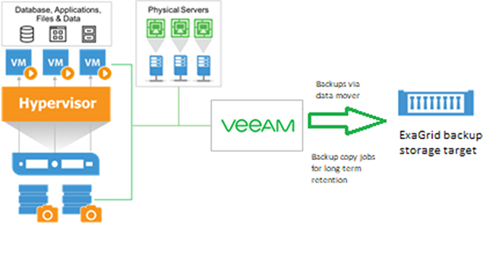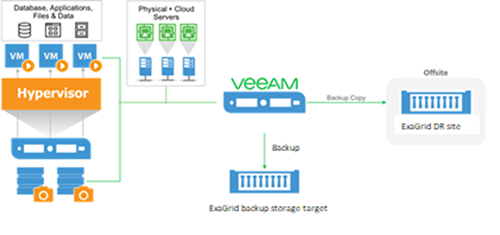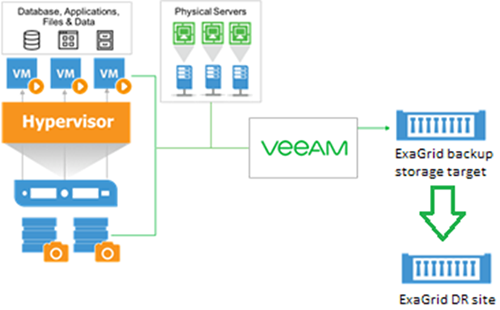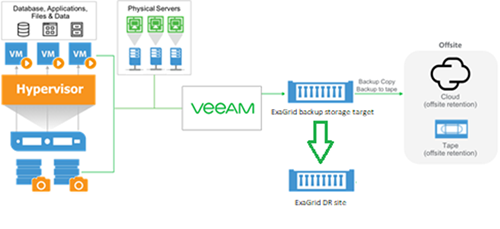Ready to Talk to a System Engineer?
Please enter your information and we'll contact you to set up a call. Thank you!
Architecture Guidelines for Backup Storage
Challenge
Organization that want to use Veeam Backup & Replication with ExaGrid Tiered Backup Storage should consider the following guidelines specifically if there is a requirement for:
- High performance and security with Veeam features such as the Veeam Data Mover or those that utilize random I/O like Instant VM Recovery, Data Labs, database point-in-time restore, and others mentioned in Veeam KB2660 without needing to add a non-deduplicating storage system as the primary backup target.
- Cost-effective, long-term backup retention (e.g., 4 weeks or longer).
- Fast restores from backup chains with recent backups.
- Scale-out backup storage that handles data growth over time without having to perform forklift upgrades or cyclical product replacement.
Cause
With the demand placed on backup storage in these scenarios, it is important to consider the hardware configuration as it pertains to where backups are stored.
Solution
Below are some hardware configuration options that can be used with ExaGrid’s Tiered Backup Storage appliances to enable the desired performance across all scenarios. In some cases, there may be a need to combine characteristics of more than one option, but in all cases, it is strongly recommended that you consult with ExaGrid and/or a value-added reseller to discuss individual needs.
More details about deduplication systems best practices can be found in Veeam KB1745, including how Veeam Scale-out Backup Repository (SOBR) is best utilized with ExaGrid’s scale-out architecture and how the Veeam Data Mover is uniquely integrated with the ExaGrid appliances for the highest ingest and synthetic full performance.
The industry’s 3-2-1 backup rule can be used as a guideline for backup infrastructure planning:
3: Maintain at least three copies of your data and applications – that’s the one copy you’re using and two backups. This way, if one of your backups is unavailable for any reason (such as the backup is co-located with your primary copy and both go down), you can still recover what you need.
2: Store your backups on at least two different types of media or storage controller logics. One reason for this is that each type of media has its own vulnerabilities, and you don’t want both of your backups susceptible to the same problem.
1: Keep one of the backups in a different location. Consider a crisis in your primary data center, such as a fire or power failure. If all of your copies are collocated, they can all be affected, taking down your organization.
Building backups on the first site with both short- and long-term retention on ExaGrid Tiered Backup Storage – A backup storage system made up of multiple ExaGrid appliances of the correct capacity is used to hold both short-term and extended long-term primary backups. With ExaGrid Tiered Backup Storage, there is no need for disk to be placed in front a deduplication appliance as ExaGrid has a front-end disk-cache, called a Landing Zone, which ingests data in undeduplicated form at high-speed for fast backups and restores. This approach avoids the performance issues of traditional inline deduplication. ExaGrid then tiers the data to a repository that stores long-term retention data in deduplicated form for cost efficiency. Note that only ExaGrid Field System Engineers perform the sizing of the ExaGrid solution based on a customer’s environment to ensure 100% sizing accuracy.
Backup job restore points are available in ExaGrid’s unique Landing Zone, which provides primary backup storage random I/O performance for Veeam Technologies (see Veeam KB2660). Restores of Veeam backups kept in the Landing Zone require no rehydration or processing.
Veeam V10’s ability to keep certain full backups longer for archival purposes allows specification of a GFS retention policy directly on Veeam Backup Jobs – no need for Veeam Backup Copy Jobs.
Add offsite target – in addition to the above scenarios, you can use the following options to create an offsite copy of your data:
- Implement ExaGrid appliances at a second site and use Veeam Backup Copy Jobs with optional WAN acceleration to create the offsite copy of the Veeam backups.

- Implement ExaGrid appliances at a second site and use ExaGrid replication to create the offsite copy of the Veeam backups.

Using the first option above has the benefit of Veeam doing integrity checking during the copy jobs allowing Veeam to manage different retention settings at the two sites, and InstantVM (and other vPower) operations at the second site. ExaGrid’s replication and WAN encryption is a proven and reliable technology, making this option a valid approach.
Using the second option above requires re-scanning, which must be done prior to recovery from a second site. The rescan takes only a few minutes and does not significantly impact DR RTOs (see Veeam Re-Scanning Article).

- Add a tape system at another site or in the cloud – Use Veeam Backup to Tape Jobs or Veeam’s Cloud Tier (connection to object storages) to store data offsite. Combining ExaGrid WAN-efficient replication of backup retention with Veeam’s backup archive to cloud allows you to balance DR service-level requirements with cost of implementation. No rehydration is required to backup data to offline media because the backup data is not in a deduplicated state in the ExaGrid Landing Zone. Additionally, compression should be enabled when copying backup data to offline media in order to save space since the backup data in the Landing Zone is uncompressed. This will reduce the amount of offline media resources required.

